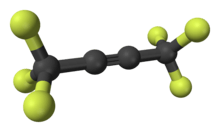Hexafluoro-2-butyne
Hexafluoro-2-butyne (HFB) is a fluorocarbon with the chemical structure CF3C≡CCF3. HFB is a particularly electrophilic acetylene derivative, and hence a potent dienophile for Diels–Alder reactions.[1][2]
 | |
 | |
| Names | |
|---|---|
| IUPAC name
1,1,1,4,4,4-Hexafluoro-2-butyne | |
| Other names
HFB | |
| Identifiers | |
3D model (JSmol) |
|
| ChemSpider | |
| ECHA InfoCard | 100.010.667 |
PubChem CID |
|
| RTECS number |
|
CompTox Dashboard (EPA) |
|
| |
| |
| Properties | |
| C4F6 | |
| Molar mass | 162.034 g·mol−1 |
| Appearance | Colorless gas |
| Density | 1.602 g/cm3 |
| Melting point | −117 °C (−179 °F; 156 K) |
| Boiling point | −25 °C (−13 °F; 248 K) |
| Insoluble | |
| Structure | |
| 0 D | |
| Hazards | |
| Main hazards | Toxic gas |
| R-phrases (outdated) | R12 R23 |
| S-phrases (outdated) | S16 S33 S45 |
| Related compounds | |
Related compounds |
Dimethyl acetylenedicarboxylate Hexachlorobutadiene Acetylene |
Except where otherwise noted, data are given for materials in their standard state (at 25 °C [77 °F], 100 kPa). | |
| Infobox references | |
HFB is prepared by the action of sulfur tetrafluoride on acetylenedicarboxylic acid or by the reaction of potassium fluoride (KF) with hexachlorobutadiene.
References
- Essers, Michael; Haufe, Günter (2006). "Hexafluoro-2-butyne". Encyclopedia of Reagents for Organic Synthesis. doi:10.1002/047084289X.rn00669. ISBN 0471936235.
- E S Turbanova, A A Petrov (1991). "Perfluoroalkyl(aryl)acetylenes". Russian Chemical Reviews. 60 (5): 501–523. Bibcode:1991RuCRv..60..501T. doi:10.1070/RC1991v060n05ABEH001092.
This article is issued from Wikipedia. The text is licensed under Creative Commons - Attribution - Sharealike. Additional terms may apply for the media files.